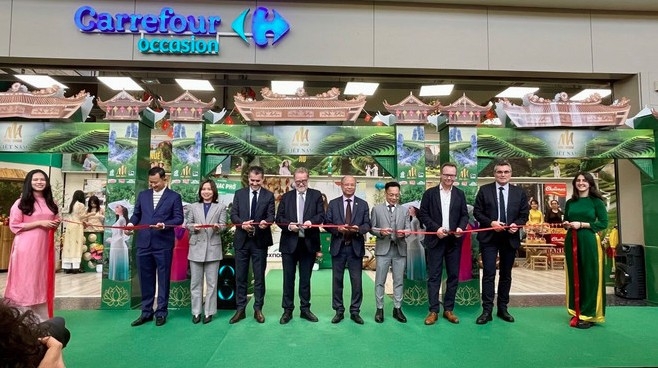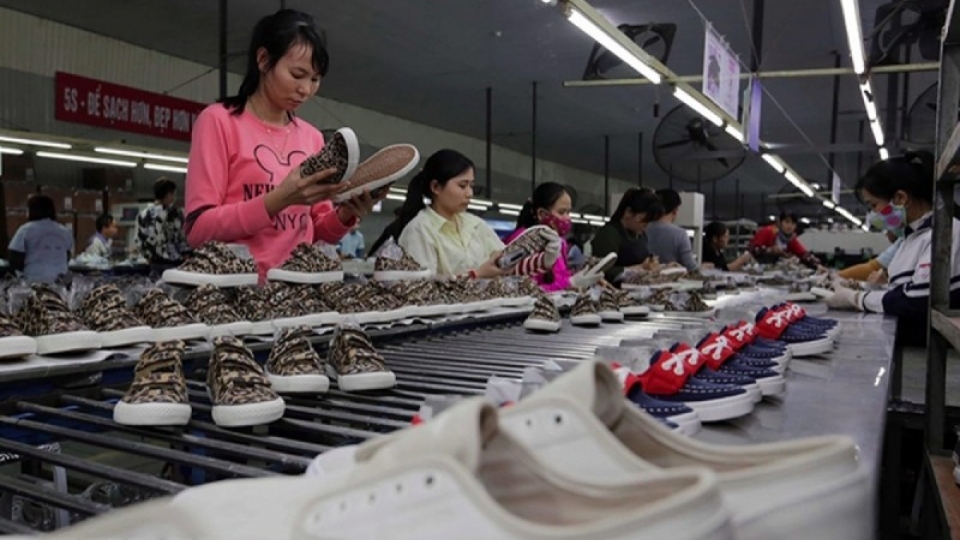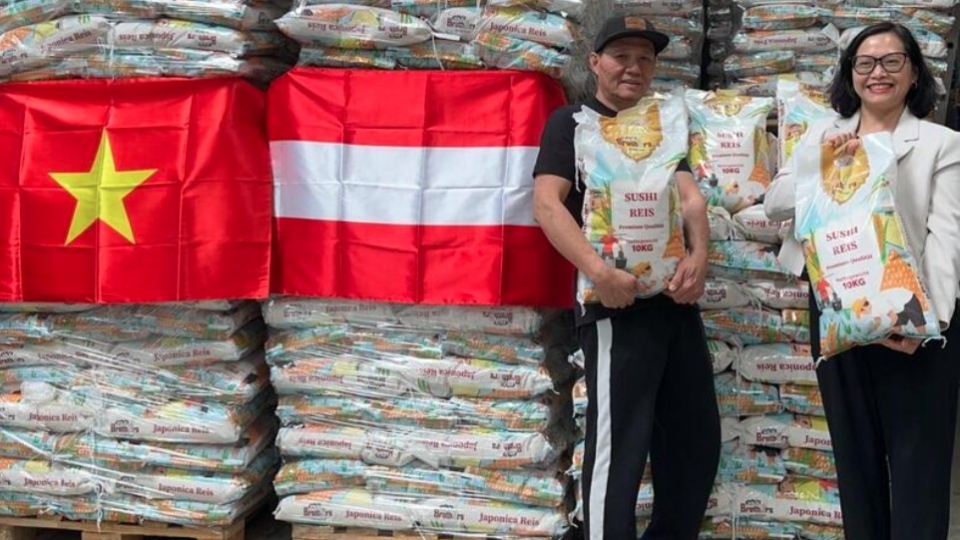Five years of EVFTA fuel growth in Vietnam-France trade
VOV.VN - Over the past five years, the EU-Vietnam Free Trade Agreement (EVFTA) has spurred double-digit export growth, strengthened investment ties, and helped Vietnam secure a stronger foothold in the French and EU markets.

Head of the Vietnam Trade Office in France Vu Anh Son has spoken to the press in Paris, offering a comprehensive assessment of the EVFTA’s impact on bilateral trade as well as strategic directions for the years ahead on the occasion of the agreement’s fifth anniversary.
Since coming into force in August 2020, the EVFTA has stood out as one of the most pivotal milestones in the economic relations between Vietnam and the EU, and between Vietnam and France in particular. Amid unprecedented global turbulence brought on by the COVID-19 pandemic, geopolitical tensions, and supply chain disruptions, the agreement has served as a vital stabilizing anchor for bilateral trade.
Vu Anh Son highlighted the remarkable resilience of Vietnam–France trade relations as one of the most notable aspects over the past five years."
He emphasized, “Five years after the EVFTA officially entered into force, trade between Vietnam and France has not only posted impressive growth in scale but also demonstrated strong resilience and adaptability in the face of unprecedented global supply chain disruptions.”
Between 2021 and 2024, Vietnam–France trade saw a strong rebound, with export turnover rising from US$6.1 billion to US$7.5 billion, up 23% from the start of the period and well above the pre-COVID peak of US$6.5 billion in 2019.
Vu Anh Son noted that the EVFTA has brought more than just tariff advantages, it has spurred reforms in rules of origin, strengthened goods management, and broadened access to logistics, financial, and insurance services.
A particularly notable milestone was the official upgrade of bilateral ties to a “Comprehensive Strategic Partnership” during Party General Secretary To Lam’s visit to France in October 2024. This event has reinforced political and diplomatic ties while paving the way for broader economic and trade cooperation, with expectations for bilateral trade to grow 6–7% annually and reach US$12–15 billion in the coming years.
In terms of investment, the EVFTA has played a vital role through its commitments on investment protection, national treatment, and most-favored-nation status. French capital has primarily flowed into high-value sectors such as precision engineering, renewable energy, environmental technology, pharmaceuticals, and high-tech agriculture. Vu Anh Son stressed, “The presence of major corporations like Schneider Electric, Pernod Ricard, and Boehringer Ingelheim has elevated Vietnam’s management capacity and product quality, enabling domestic enterprises to meet the EU’s stringent standards.”
He further noted that the success of these sectors was not a matter of chance, but rather “a convergence of three key factors: direct competitive advantages from tariff preferences, the right timing as Europe sought to diversify its supply chains, and the internal capabilities and proactive strategies of Vietnamese businesses.”
Textiles and garments, and footwear are among the sectors that have benefited most directly and visibly from the EVFTA. Prior to the agreement, these industries faced relatively high import tariffs when entering the EU market. The gradual elimination of tariffs under the EVFTA has provided Vietnamese products with a clear price advantage. Major French retailers such as Decathlon have capitalized on this and significantly increased their orders from Vietnam.
Meanwhile, the agricultural and seafood sectors have seen remarkable growth, offering clear proof of Vietnam’s ability to penetrate even the most demanding segments of the EU market.
Vu Anh Son remarked, “The success story of Vietnamese rice is a prime example. Through active trade promotion and effective use of duty-free quotas, Vietnamese rice has entered major French supermarket chains such as Carrefour and Leclerc.”
This achievement was made possible by pioneering enterprises that invested in production, processing, and traceability systems in line with GlobalG.A.P. and ASC standards, successfully overcoming the EU’s stringent technical barriers.
While not as frequently cited as textiles or agriculture, electronics, machinery, and components represent Vietnam’s largest export category, playing a pivotal role in the global supply chain. Vietnam has emerged as a key hub for electronics manufacturing and assembly, with products such as phones, computers, and electronic parts accounting for a big share of exports to France and the EU.
However, Vu Anh Son also candidly pointed out a troubling paradox: “Growth in absolute value has not translated into deeper market penetration.” A report by France’s Ministry of Finance indicated that since 2019, Vietnam’s market share in France has seen little improvement, saying that that tariff removal is only the starting point.
In the textile sector, Vu Anh Son stated that the EU is tightening regulations on circular economy and sustainable fashion, requiring garments to be more durable, easier to recycle, and contain a certain proportion of recycled fibers, thus posing major technological and cost-related challenges for manufacturers.
Meanwhile, the agricultural, forestry, and seafood industries are also facing increasingly rigorous barriers from the EU, often referred to as the “Green Wall.” These include some of the world’s strictest sanitary and phytosanitary (SPS) measures, particularly regarding pesticide and antibiotic residue limits.
In the face of these challenges, Son accentuated the need to turn barriers into drivers of growth. He noted that the EU’s Green Deal represents both a major challenge and a unique opportunity for Vietnam to innovate and advance.
“Vietnam can gain a first-mover advantage by combining the implementation of the Just Energy Transition Partnership (JETP) with efforts to meet the requirements of the EU’s Carbon Border Adjustment Mechanism (CBAM) and Corporate Sustainability Due Diligence Directive (CSDDD),” he said.
To overcome challenges and move up the global value chain, Vu Anh Son proposed that Vietnam focus on three strategic pillars.
To overcome challenges and move up the global value chain, Vu Anh Son proposed that Vietnam focus on three strategic pillars: The first is to build strong domestic industrial capacity. He called for a shift from a passive FDI attraction model to a proactive industrial policy, with targeted incentives for supporting industries—particularly FDI in upstream sectors such as textile dyeing, specialty chemicals, and high-tech components.
The second is to modernize logistics and digital infrastructure in order to reduce costs and boost competitiveness.
The third is to develop high-quality human resources that meet the requirements of emerging industries and international standards.
He also underscored the importance of proactive economic diplomacy. He urged Vietnam to actively negotiate Mutual Recognition Agreements (MRAs) with the EU on conformity assessment and technical standards to ease the certification burden on exports. At the same time, he called for engagement with the European Commission to ensure that Vietnam’s carbon pricing mechanisms and greenhouse gas reporting standards are recognized as equivalent to those of the EU, thereby helping to mitigate the impact of the CBAM.
The biggest internal challenge, according to Vu Anh Son, lies in policy coordination. To deal with this, he recommended establishing a national steering committee on FTA implementation and value chain upgrading. “This is not about creating another layer of bureaucracy. It’s a structural solution to a structural problem,” he stressed.
Looking ahead, Vu Anh Son expressed optimism about the prospects of Vietnam–France cooperation under the EVFTA framework, noting that five years of implementation have significantly advanced bilateral trade ties. He emphasized that the agreement not only delivers economic benefits but also serves as a strategic stabilizing factor in the relationship between the two countries.
With the elevation of ties to a Comprehensive Strategic Partnership, he voiced hope for new breakthroughs in Vietnam–France economic and trade cooperation. Vietnam, he said, is increasingly positioning itself not just as a manufacturing hub but as an indispensable link in the global value chain.
“Amid global uncertainty, the EVFTA has helped forge a resilient Vietnam–France supply chain, solidifying Vietnam’s role as a trusted trade partner in the Indo-Pacific,” he added.
With a solid five-year foundation and clear strategic directions, Vietnam–France trade relations under the EVFTA are poised for continue growth, making a positive contribution toward achieving higher trade volumes in the years ahead.




